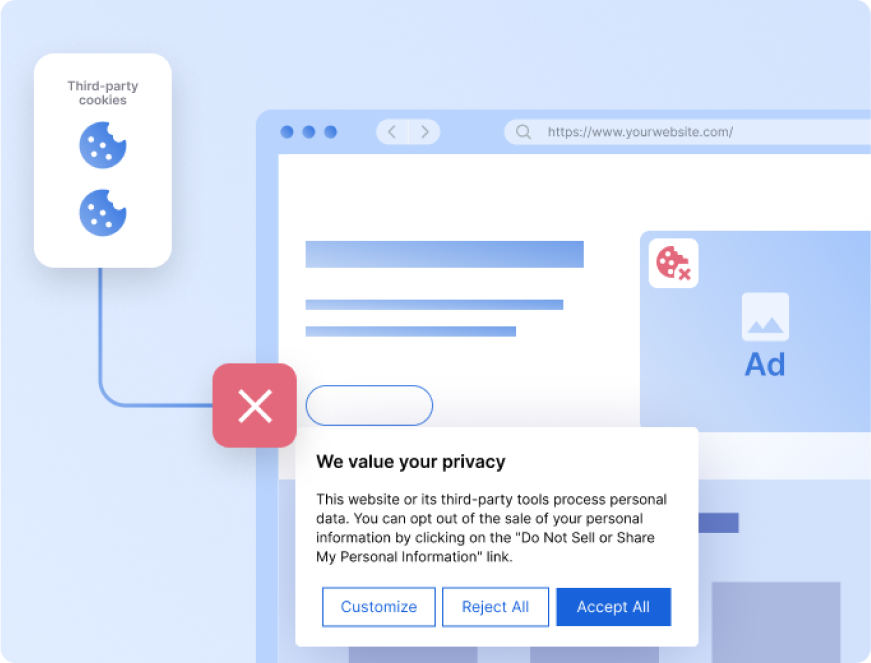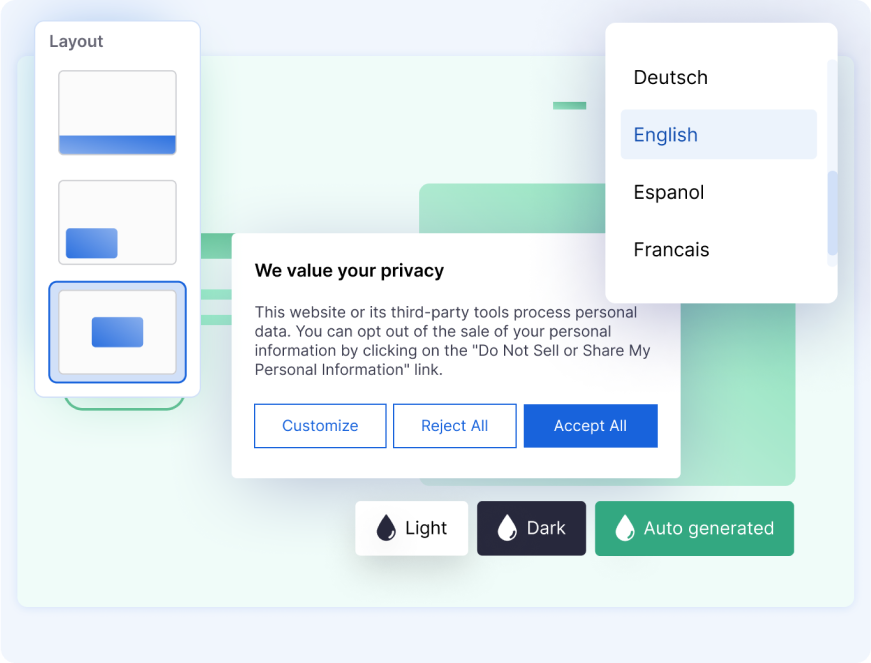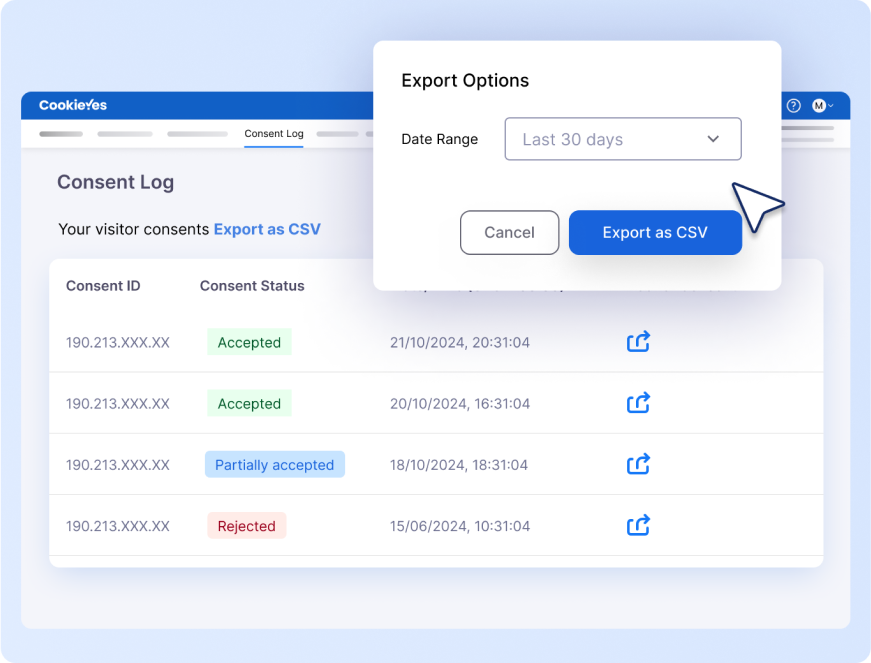Estimated reading time: 15 minutes
Table of contents
- The Evolution of the Cookie Banner
- Why We Need to Manage Our Website Compliance Like a Global Business
- What Are the Legal Tick Boxes for Compliance & Cookie Management?
- Should You Apply GDPR Globally?
- Geo-Targeting Approaches for Cookie Banners
- Cookie Consent Requirements by Country (2025)
- Understanding Google CMP and Why It Matters
- The South African E-Commerce Business: A Case for Geo-Targeted Cookie Compliance and Google CMP Integration
- How to Implement a Geo-Targeted Cookie Consent Strategy
- Final Thoughts: Finding the Right Balance
The Evolution of the Cookie Banner
Cookie banners used to be a simple formality—a small pop-up informing users about using cookies. However, as privacy laws have evolved, so have the requirements for consent management. Today, a cookie banner is more than just a notification; it’s a legal compliance tool that dictates how businesses can track, store, and use customer data.
The General Data Protection Regulation (GDPR) was the first significant law to set the standard for data privacy, and its effects have rippled worldwide. But it’s no longer the only player—businesses must now navigate multiple privacy laws, including CCPA (California), POPIA (South Africa), Québec’s Law 25, LGPD (Brazil), PIPL (China), and more.
So, how do you ensure your website cookie banner is compliant without destroying your ability to collect valuable user data?
Why We Need to Manage Our Website Compliance Like a Global Business
Let’s take the example of a South African e-commerce business that is fully POPIA (Protection of Personal Information Act) compliant. The company believes it’s covered because it follows local laws. However, when a customer from France submits a form on its website, GDPR compliance is triggered.
Most privacy laws now have extraterritorial reach—meaning they apply based on the website visitor’s location, not just where your business operates. This means that even if your company does not intend to provide services in a particular country, the mere fact that a user from that country interacts with your website could make you subject to that country’s privacy laws.
Here’s a quick breakdown of major global privacy laws that could impact your website:
| Privacy Law | Applies to Non-Local Businesses? | Key Triggers for Applicability | Examples of Website Interactions That Trigger Privacy Law |
|---|---|---|---|
| GDPR (EU) | Yes, if processing EU resident data | A visitor from the EU interacts with your site, even if you don’t target EU customers | Product purchase, completing & storing form info, creating an account, tracking behaviour via cookies |
| FADP (Switzerland) | Yes, if processing data of Swiss residents | The FADP applies to any processing of personal data related to Swiss individuals, even by businesses outside Switzerland, if the data processing has an effect in Switzerland. | The FADP applies to any processing of personal data related to Swiss individuals, even by businesses outside Switzerland, if the data processing affects Switzerland. |
| CCPA (California, US) | Only if thresholds are met | A California resident visits your site, and their data is collected, even if they don’t purchase | Product purchase, collecting personal data for targeted advertising, selling customer data |
| POPIA (South Africa) | Yes, if processing happens in SA | A South African visitor interacts with your site, and their data is processed | Product purchases, subscribing to a newsletter, entering a competition, storing customer details |
| Law 25 (Québec, Canada) | Yes, if collecting data from Québec residents for commercial purposes | A Québec visitor provides personal information on your site | Creating an account, form submission, applying for a service, subscribing to email updates |
| PIPEDA (Canada – Federal) | Yes, if processing data of Canadian residents in commercial activities | A Canadian visitor submits personal data on your website | Product purchase, submitting payment details, filling out a feedback form |
| PDPA (Singapore) | Yes, if processing data of Singaporean residents | A Singaporean visitor interacts with your website, and their data is collected | Completing a checkout process, signing up for an account, using a chatbot that collects user details |
| LGPD (Brazil) | Yes, if collecting Brazilian resident data | A Brazilian visitor submits personal data on your site, even if they don’t buy | Requesting a quote, submitting a complaint, downloading a whitepaper |
| PIPL (China) | Yes, if processing Chinese resident data abroad | A Chinese visitor interacts with your website, even if you don’t market to China | Registering an account, collecting customer insights via analytics, processing online transactions |
For businesses like our South African e-commerce example, compliance isn’t just about local laws—it’s about adapting to global privacy frameworks based on who visits your website.
What Are the Legal Tick Boxes for Compliance & Cookie Management?
If your business collects, stores, or processes personal data from EEA (European Economic Area), Swiss, UK, or other regulated regions, here’s what you need to
Legal & Technical Setup
- Determine if GDPR applies to you (Do you serve EU customers or potentially collect their data?)
- Update your Privacy Policy & Cookie Policy to reflect GDPR guidelines.
- Ensure you have a lawful basis for data collection (consent, contract, legal obligation, legitimate interest).
- Implement a GDPR-compliant Cookie Banner (more on this later).
Cookie Tracking & Consent Management
- Use a Google CMP-compliant Consent Management Platform (CMP).
- Allow users to opt in or out before cookies load.
- Enable granular consent (Essential, Functional, Performance, Marketing cookies).
- Log proof of consent in case of regulatory audits.
User Rights & Data Handling
- Provide a method for users to request data access, deletion, or modification.
- Set up data retention policies (don’t store unnecessary data).
- Secure personal data storage with encryption and limited access.
- LGPD (Brazil) – Requires an easy opt-out of marketing communications, like CCPA, but distinct from GDPR’s consent mechanism

Should You Apply GDPR Globally?
As digital privacy regulations evolve, businesses face increasing pressure to comply with international laws while maintaining effective data collection strategies. One of the biggest challenges comes from cookie consent banners, which are required under laws like GDPR (Europe), CCPA (California), and LGPD (Brazil).
Many businesses default to applying GDPR-level restrictions worldwide, assuming this is the safest option.
Does Applying GDPR Globally Cover Other Privacy Laws?
Applying GDPR globally provides a strong baseline for compliance, but it does not automatically cover all other privacy laws. While GDPR is one of the strictest data protection laws, different regulations have unique requirements that GDPR alone may not fulfil.
What GDPR Covers That Helps With Other Privacy Laws
- Explicit Consent Requirement (meets most laws like LGPD, Law 25, and PIPL).
- Right to Access, Rectify, and Delete Data (meets CCPA, POPIA, PIPEDA).
- Security & Data Protection Standards (suitable for all major privacy laws).
- Transparency in Data Processing (helps with CCPA, PIPEDA, LGPD, Law 25).
Where GDPR Falls Short of Other Laws
- CCPA (California, US) requires an opt-out option rather than an opt-in model for selling personal data.
- POPIA (South Africa) requires businesses to register Information Officers and mandates specific data breach reporting timelines.
- PIPL (China) requires data localisation for sensitive personal data.
If you want a one-size-fits-most approach, applying GDPR globally is a strong strategy because it covers the most stringent requirements.
However, if you operate in California, South Africa, Brazil, or China, you may need additional compliance measures beyond GDPR.
Detrimental impact on ad performance and marketing efficiency
However, this approach can severely impact advertising performance, data analytics, and overall marketing efficiency.
A more effective strategy involves geo-targeting cookie banners, ensuring compliance where necessary while maximising data collection in unrestricted regions.
A better approach could be geo-targeted compliance, where:
- GDPR applies in the EU, UK, and Switzerland
- CCPA rules apply to California visitors
- POPIA rules apply to South African visitors
- PIPL rules apply to Chinese visitors
This balances compliance with data retention needs and prevents over-restricting non-GDPR regions, which could harm marketing and analytics efforts.

Geo-Targeting Approaches for Cookie Banners
Option 1: Non-Geo-Targeted Cookie Banners
How It Works
A non-geo-targeted cookie banner applies GDPR-level tracking restrictions globally, regardless of where a visitor is located. All users, whether in Europe, the US, or other regions, must explicitly opt into tracking before cookies can be activated.
Why It’s a Problem
- Blocks data collection unnecessarily in regions where GDPR rules do not apply, such as the US, Australia, and many parts of Asia.
- Harms digital marketing performance, including Google Ads, Facebook Ads, and LinkedIn retargeting, by limiting the ability to track and target users.
- Reduces the effectiveness of conversion tracking, making it harder to measure ad performance and optimise campaigns.
- Increases website abandonment rates, as users often reject tracking when presented with complex consent options that may not be legally required in their region.
Who Should Use This?
- Businesses that only operate within GDPR regions (European Economic Area, UK, and Switzerland).
- Organisations that prioritise legal compliance over marketing performance and do not rely heavily on tracking-based advertising.
- Government or non-profit websites that do not use extensive behavioural tracking or personalised marketing.
Option 2: Geo-Targeted Cookie Banners
How It Works
A geo-targeted cookie banner applies GDPR-compliant consent mechanisms only where required while allowing standard tracking practices in regions where explicit consent is not legally mandated.
For example:
- Users in GDPR-regulated areas (EEA, UK, and Switzerland) receive a fully compliant cookie banner, ensuring that tracking occurs only after explicit consent.
- Users outside GDPR regions (such as the US, Canada, and Australia) receive a standard cookie consent banner, allowing immediate data collection without unnecessary restrictions.
Why It’s the Smarter Choice
- Maximises data collection in regions with more flexible consent requirements, ensuring businesses can track user behaviour and optimise marketing strategies effectively.
- Improves advertising efficiency, allowing Google Ads, Meta Ads, and LinkedIn campaigns to function correctly in non-GDPR regions.
- Reduces unnecessary friction in user experience, ensuring that website visitors in non-regulated areas are not overwhelmed with excessive privacy prompts.
- Balances compliance with business needs, ensuring full legal adherence where required without sacrificing global marketing insights.
Who Should Use This?
- Businesses that operate in multiple regions, including both GDPR and non-GDPR territories.
- E-commerce brands, digital advertisers, and SaaS platforms that rely on data-driven marketing strategies.
- Publishers and media platforms that monetise content through advertising and require efficient tracking mechanisms.
- Organisations use Google Ads, Facebook Pixel, LinkedIn Insights, or other tracking-based advertising tools to increase customer acquisition and conversions.
Cookie Consent Requirements by Country (2025)
| Consent Model | Country / Region | Cookie Consent Requirement |
|---|---|---|
| Opt-in | European Union (EEA) | Must obtain explicit, informed consent before setting non-essential cookies (GDPR + ePrivacy). |
| Opt-in | United Kingdom | Prior consent required for cookies, except those strictly necessary (UK GDPR + PECR). |
| Opt-in | Switzerland | Requires active consent for tracking and analytics cookies (revDSG / nFADP). |
| Opt-in | Brazil | Consent required before using cookies to process personal data (LGPD). |
| Opt-in | South Africa | Explicit consent needed before setting cookies with personal data (POPIA). |
| Opt-in | Québec (Canada) | Consent must be obtained before setting identifying cookies (Law 25). |
| Opt-in / Implied | Canada (Federal) | Express or implied consent depending on sensitivity and expectations (PIPEDA). |
| Opt-in | Singapore | Consent required for cookies that collect or link to personal data (PDPA). |
| Opt-in | China | Explicit consent required for cookie-based tracking (PIPL). |
| Opt-in | Saudi Arabia | Requires consent for all personal data processing, including cookies (PDPL). |
| Opt-in | Argentina | Prior consent required for data collection via cookies (PDPL). |
| Opt-in | Andorra | Explicit consent needed before using tracking cookies (LQPD). |
| Opt-in | Faroe Islands | GDPR-aligned rules require opt-in consent for cookies. |
| Opt-in (Planned) | India | DPDP Act expected to require consent for cookies tied to personal data. |
| Opt-out | California (USA) | Must allow users to opt out of data sale/tracking; prior cookie consent not mandatory (CCPA). |
| Opt-out | Other US States | Users must be able to opt out of targeted advertising and tracking; no required opt-in. |
| None | United States (Federal) | No national cookie law; depends on individual state laws. |
| None | Australia | No specific cookie law yet; general privacy applies, reform is in progress. |
| None | New Zealand | No law requiring cookie consent banners. |
| None | United Arab Emirates | Data law (DPL 2021) exists, but no specific cookie consent requirements yet. |
| None | Japan | Cookies not directly regulated under APPI. |
| None | South Korea | Cookie consent not explicitly regulated under PIPA. |
| None | Mexico | No enforceable cookie banner requirements under current data laws. |
| None | Indonesia | PDP law lacks cookie-specific guidance. |
| None | Thailand | PDPA lacks clear cookie banner rules, but guidance is evolving. |
| None | Russia | Cookie tracking not explicitly addressed under current law. |

Understanding Google CMP and Why It Matters
In parallel to your geo-location cookie banner implementation options above, you must consider the changes in the Adtech world. More specifically, how Google manages compliance with GDPR and how other ad networks use its API to filter that consent data to their ad networks.
As global privacy regulations tighten, businesses that rely on digital marketing, analytics, and advertising must comply with laws like GDPR (General Data Protection Regulation) while maintaining effective data tracking. Google has further complicated the compliance landscape by introducing Consent Management Platform (CMP) requirements for businesses using Google Ads in GDPR-covered regions (EEA, UK, and Switzerland).
This means that if you run paid campaigns, Google requires you to use an approved CMP that integrates with Google’s CMP API—or risk losing the ability to serve personalised ads in regulated markets.
Google’s CMP policy requires websites that use Google Ads, Google Display Network, or other advertising products to obtain valid user consent before collecting data from visitors in GDPR-regulated regions.
Key Aspects of Google CMP Compliance
CMP API Integration
The consent tool must connect to Google’s Consent Mode API, ensuring that Google receives real-time user consent data. Without this integration, Google will block personalised ads, significantly reducing the effectiveness of Google Ads campaigns.
Region-Specific Compliance
The CMP must differentiate between users in GDPR regions, where consent is required, and users in non-GDP areas, where tracking may be more flexible. Non-compliant setups often apply GDPR restrictions globally, unnecessarily limiting data collection in regions without regulation.
Support for Google Ad Partner Networks
Google’s ecosystem comprises thousands of advertising partners that rely on accurate consent signals to deliver targeted ads. A proper CMP ensures that consent settings are shared with Google, its ad partners, and affiliated networks, maintaining ad performance.
Granular Consent Control
Users must be able to allow or block cookies based on category (e.g., Strictly Necessary, Performance, Functional, and Marketing cookies). The CMP must record this data and update Google accordingly.
Audit-Proof Consent Storage
Businesses must keep records of user consent to demonstrate compliance in case of audits by regulators or ad partners. Google CMP-approved tools securely store these logs and ensure they are easily accessible if needed.
Without a Google CMP-approved tool, businesses risk:
- Loss of advertising efficiency, as Google Ads will no longer serve personalised ads to European users.
- Non-compliance with GDPR, leading to potential fines and legal issues.
- Reduced data collection, affecting website analytics and marketing effectiveness.
Essential Features of a Google CMP-Compliant Consent Tool
Geo-Targeting Capabilities
A proper CMP must be able to differentiate between users in GDPR-regulated areas and other regions. This allows businesses to apply strict consent mechanisms where necessary while maintaining regular tracking outside GDPR zones. Geo-targeting prevents unnecessary restrictions that could negatively impact marketing performance in non-regulated regions.
Google CMP Integration
The consent tool must integrate with Google’s CMP API to ensure Google receives user consent data in real time. The CMP must support Google Consent Mode, allowing data collection preferences to be adjusted dynamically based on user selections.
Granular Consent Options
Users should be able to allow or block cookies by category rather than just accepting or rejecting all tracking. The CMP should provide transparent descriptions of what each category does, enabling informed user decisions.
Proof of Consent Storage
The tool must log consent choices securely and store them for future reference. This protects businesses in case of audits by regulators, advertising partners, or data protection authorities.

The South African E-Commerce Business: A Case for Geo-Targeted Cookie Compliance and Google CMP Integration
Let’s jump back into our South African website business example to illustrate the impact of geo-targeted cookie compliance and Google CMP integration.
Let’s consider a South African e-commerce business that primarily sells products to local customers but also receives international website traffic.
Initial Compliance Efforts and Unexpected GDPR Exposure
The business operates under South Africa’s Protection of Personal Information Act (POPIA) and initially assumes GDPR does not apply since it doesn’t market to Europeans. However, as visitors from France, Germany, and the UK begin submitting enquiries, GDPR compliance obligations arise. The business must now decide whether to apply GDPR globally or adopt a geo-targeted approach for EU visitors only.
The Geo-Targeting Decision: Maximising Compliance Without Losing Data Applying GDPR globally would unnecessarily restrict South African customers, harming personalisation and marketing performance. Instead, they implement a geo-targeted cookie consent solution, which:
- Applies GDPR-compliant consent banners only to EU, UK, and Swiss visitors.
- Keeps standard tracking for South African users to optimise marketing campaigns.
- Maintains ad performance for Google Ads without unnecessary GDPR limitations. This approach preserves compliance while supporting a strong marketing strategy.
Google CMP Compliance
The Next Challenge After implementing geo-targeted consent, the business faces new challenges with Google’s CMP compliance. Personalised ads stop serving in the EU due to missing consent integration. Realising that CMP compliance is vital for Google Ads, they:
- Switch to a Google-approved CMP that integrates with Google’s Consent Mode API.
- Enable real-time consent tracking, ensuring data is collected only when users opt in.
- Sync consent preferences with Google’s Ad Partner Network to optimise ad performance.
The Outcome
Compliance + Marketing Efficiency
With geo-targeted consent and Google CMP integration, the business achieves:
- GDPR compliance for EU visitors without restricting tracking elsewhere.
- POPIA compliance for South African users.
- Full Google Ads functionality, maintaining personalised ads across all markets.
- Optimised marketing and analytics, improving retargeting and conversion tracking.
- Balancing regulatory requirements with marketing performance makes the business competitive and compliant in a changing privacy landscape.
How to Implement a Geo-Targeted Cookie Consent Strategy
To effectively manage geo-targeted cookie banners, businesses should:
- Use a Consent Management Platform (CMP) with geo-targeting capabilities, such as CookieYes Cookie Banners.
- Configure region-based rules to apply strict GDPR settings only in required locations while maintaining standard tracking elsewhere.
- Ensure Google CMP compliance to continue running personalised ads within the Google ecosystem and that you are working with a cookie banner technology that is Google Compliant.
- Log user consent preferences and store them securely in case of regulatory audits.
- Regularly update privacy policies and cookie settings to align with changing data protection laws.

Final Thoughts: Finding the Right Balance
Choosing between non-geo-targeted and geo-targeted cookie banners is critical to compliance and marketing performance. While global GDPR applications may seem the safest option, they often come at the cost of data collection and advertising efficiency.
A geo-targeted approach ensures businesses remain compliant where necessary while still collecting the data needed for effective marketing and analytics. By implementing region-specific cookie consent mechanisms, companies can strategically navigate privacy regulations—ensuring legal protection and business growth.





